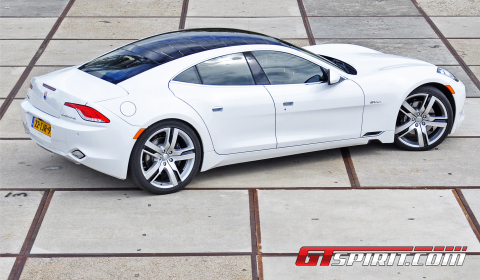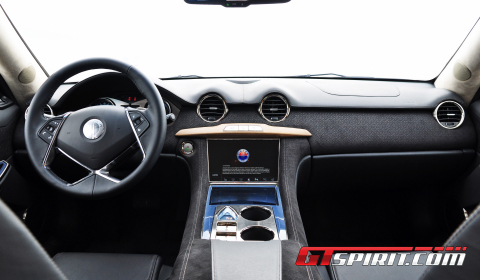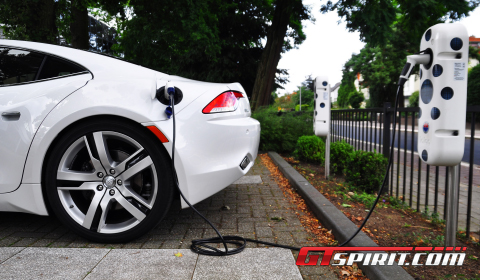The Fisker Karma plug-in hybrid has entered and already left our GTspirit garage. Known to many of our readers as the first luxurious petrol-engined four-door saloon with an electric range extender, it was time to take the four-seater for a road test.
The man behind America’s youngest automaker and the Karma EV is Hendrik Fisker, a Danish-born designer responsible for the BMW Z8 and Aston Martin Vantage. A man who used his vision and experience in the automotive world to develop an outrageous looking machine, offering enough space for four people and a heap of sustainability. After securing a nine figure investment package to support the engineering development of the Karma and its plug-in hybrid powertrain, Fisker started the multinational project with people from across the world being involved in the development and production of the luxury EV.
Currently the Karma is being assembled by Valmet in Finland and shipped around the world. The biggest markets are currently their home country USA and surprisingly the Netherlands, selling over a hundred Karma’s in a rather small country and within a period of one year. The interest in the model is fueled by tax benefits and environmental funds from local governments and cities trying to push electric-powered vehicles forward in sales, usage and acceptance. The Karma is a clear example of the Going green hype and part of a new marketing perspective in the automotive business.
Available for our road test was a White Sand Fisker Karma EcoSport. In total three different packages are available for the 2+2 sedan; EcoStandard, EcoSport and EcoChic. Each offers its lineup of accessories and a range of available colors and interiors. Only seven different interior setups and eight exterior colors are available for the three models. Aftermarket suppliers please note that the 22 inch Circuit Blade rims are the only available wheel option for the Karma.

The powersource inside the Karma is the main conversation point for this story. Of course, we will look at the handling, build quality and versatility of the luxury vehicle, but the key feature is the plug-in hybrid drivetrain consisting of two parts. At the front of the car Fisker placed a 2.0 liter direct-injection and turbocharged four-cylinder petrol unit sourced through GM and tuned to deliver 260hp plus 353Nm of torque. The range extender is trained to run within its maximum efficiency window whenever possible. The combustion engine feeds a generator which creates electricity for the two drive motors at the back, each good for 105kW. When fully charged using the charging cable and socket on the rear-left hand side of the car, the 20kWh lithium-ion battery pack provides a range of up to 80km, but only if you keep your foot steady on the throttle.
The total performance of the Karma offers a sprint to 100km/h in 6.3 seconds using the range extender and 7.9 when only the electric engine is engaged. The top speed is limited to 200km/h and 153km/h in EV or Stealth mode. The lack of ultimate performance is mainly due to the sheer weight of the EV. The Karma weighs an astonishing 2,400kg and is five meters in length. It is clearly not a small car, but a rather S-Class sized luxury car offering a reasonable amount of space for 2+2 passengers. The rear trunk space is limited to just 195 liter, not enough for four people’s luggage.
Driving the Fisker Karma, means opening yourself to a silent world of technical gizmos combined with environmental highlights across the interior. The car maker aimed to make the driving experience as straightforward as possible by minimizing the number of special controls on board. So our first drive started with pressing the Toyota-sourced start button, selecting D, choosing the electric-only Stealth mode and releasing the brake pedal. The first meters meant silently moving around a big luxury vehicle, accompanied by a synthesized science fiction sound coming from the external speakers. The cool Tron-sound is audible up to 30km/h in stealth mode.
On the move, the Fisker feels quite fast in battery-only mode. The silence of its movement comes to a halt when you shift to Sport mode using the left shift paddle behind the steering wheel. The 2.0 liter engine comes to life providing a small rumble at your feet. The unknown sound source is the exhaust pipes which can be found just behind the front wheels. The other shift paddle offers the driver maximum brake generation. The strength of braking power influenced our pleasant drive and was clearly not our cup of tea so the setting was hardly chosen.

The handling is surprisingly good for a car of this size and weight. The unequal-length double-wishbone suspension front and rear has leveling dampers at the back and offers a flat, comfortable and composed ride due to the low positioning of the battery pack. The steering provides excellent feedback and a precise turn-in. It is clearly not a track weapon, but quite rewarding to say the least. The Karma is a joy to drive on open roads and excels on highways. Inside cities the larger footprint of the vehicle comes into play.
The interior offers a pleasant place to stay with special Bridge of Weir leather and a few slivers of reclaimed wood from California forest fires or, intriguingly, the bottom of Lake Michigan. The seating position for four adults is sufficient, but not overly spacious. The passengers are divided by a high center tunnel housing the battery package. Special EcoLucent plastics in the doors and center console make up the unique, luxurious and well-built cabin. A center touch-screen display offers all the multimedia, such as a navigation system, radio and control panel for the car’s electric features. The only thing we missed was the automatic setting for the windscreen wipers.
The Fisker Karma makes for excellent transport taking you from A to B in a luxurious and comfortable manner. The Karma is supremely quiet, incredibly comfortable and fairly quick. The car also offers eco-minded enthusiasts an answer to all those gas-guzzling luxury cars. So as a first effort Fisker succeeded in turning their showcar into a credible alternative fuel luxury car. The Karma is capable of delivering what it intended to do and that is an excellent achievement for a car maker that has only existed for the past five years, but we do have a point of critic.

And it is the freedom of regeneration and usage of the battery pack while driving, which in our opinion are the key ingredients of an EV with a range extender! The electric range is a potentially 80km, which should be enough for your everyday trip, but this gran turismo is made for more than just 80km of electric range. The rather dull sounding four-cylinder range extender offers the solution for people driving more than 80km, but it kills simply all the fun of driving a large luxurious EV.
While driving the Fisker in sport mode, you constantly want to move back to the stealth mode, because this is where the Fisker excels. Losing the 80km range means recharging your batteries at a static charging point for six hours, not during your trip. The onboard regeneration – including the roof solar panel – is simply too weak to provide you with a recharged battery during a longer trip and the freedom to switch to stealth mode whenever you want. The re-gen mode is available, but kills any type of driving fun and will never recharge the battery completely.
The fact that Fisker does not offer the option of recharging via the engine is clearly an environmental choice of keeping the emissions and petrol consumption of the range extender low, but we as a driver we would like to have a choice! In the end, the recharging power at a charging point may be cheaper, but the power is still created using fossil fuels in a local powerplant. The choice of not offering recharging on the go is clearly the opposite idea of driving freedom. It asks the driver to calculate his moves ahead, leaving enough juice in the battery to choose his moment of fame.
This lack of choice and freedom to go fully electric and only static recharging simply kills all the driving fun of an EV. Yes, we aren’t environmentalists! We are petrolheads enjoying the freedom of driving and experiencing unique cars. We do not want to think or plan our trip ahead, we want to have the ability to choose the best option available not feeling obstructed by the technology. Maybe that is why we will never own an EV. The main highlight of such a car is simply killed by the range of its abilities. A problem that doesn’t exist in petrol-engined sports or luxury cars.





































































Biggest market ? What biggest market ? They’ve all to a number been recalled …. again !
Oh please ! Now GTSpirit has bought ( or been paid off ) into the Fisker hype ?
I’d of thought better of you guys . So much for high expectations . Remind me in a month or two how ‘ wonderful ‘ the ( bad ) Karma is …. after its left your homes in flames .. left you stranded on the side of the road and pretty much self imploded etc etc etc . Seen the laundry list now out on all the Karma’s ills ? Its a virtual encyclopedia
Here’s that laundry list . Read it and weep …. not to mention retracting all the positive things you’re claiming about the car ;
http://jalopnik.com/5936741/leaked-fisker-document-reveals-many-annoyances-for-karma-owners
@GuitarSlinger, no worries, ours did everything really fine and the latest cars are way better then the early models coming from the factory. And no, they did not bought us, because we had a clear argument about my final statements. Those would not have been included if they paid us for an ‘advertorial’ ;)
And yes, 110 are sold in the Netherlands, only a local dealership in the US managed to do more. If you look at the market available per country, Holland is one of the major markets just because of the local tax that favors cars like this.
@GuitarSlinger, some of those things were already fixed and some will be. Ever saw such a list of another car brand who just released their first model? ;) You can come with a similar list. Let’s recall the MP4-12C not having a navigation system and the doors being a pain in the ass to open. Yes is not yet finished, but it is way better when they started and I do believe it will be way better in the months to come. Those upgrades are not part of my story. I would like to focus on the main characteristics of the car as a whole. The technique and idea behind it.
@GS i think it’s a thing with musicians as not all words need to make sense with some for it to be accepted, i believe this be the case with your brain outside of your work…